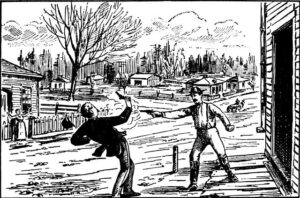
Wilton H. Strickland
It has been my great honor to publish not one, but two articles as cover stories for the Florida Bar Journal. They both address a divergence of opinion in Florida’s courts regarding premises liability, specifically over what types of third-party crimes can establish negligence by the premises owner. Though my articles provoked criticism at the time, subsequent events have proved me right, and my work is now poised to help make a seismic change in Florida law.
My Articles Are Published
The first article was published in December of 2009. In it I explained in detail how a defendant can be held liable for crimes committed on the defendant’s premises against certain types of guests (namely “invitees” and “invited licensees”). I went on to explain that a key component of this liability is whether the crime was “foreseeable,” a term that defies easy explanation. Reviewing a large number of decisions from around the state, I identified three separate criteria that Florida courts use to determine whether a prior crime makes a later crime foreseeable:
- the nature of the prior crime;
- the location of the prior crime; and
- the timing of the prior crime.
Many appellate courts were applying some or all of these criteria very loosely, allowing plaintiffs to introduce evidence of virtually any prior criminal activity no matter how dissimilar, distant, or dated. By contrast, the Third District Court of Appeal applied them all in a strict manner, excluding evidence of prior crimes unless they resembled the one at issue, were perpetrated on the premises at issue, and occurred within the prior two years. I closed my article by speculating that the Third District was doing this because a looser approach would effectively transform premises owners into insurers, something explicitly disavowed in the law of premises liability.
An irate plaintiffs’ attorney wrote a letter to the editor of the Florida Bar Journal condemning me as misportraying the law and impugning the integrity of the judiciary (though without identifying an error in my analysis). I wrote a calm and measured response explaining that the gentleman’s dispute was not with me, but with the undeniable stack of authorities on the subject.
Five years later — in December of 2014 — the Florida Bar Journal published my second article as its cover story. I was motivated to write it because the Second District Court of Appeal had weighed in on this question for the first time, holding that the court would follow a loose rather than strict approach to the foreseeability test. That holding was rather innocuous, but the court went further and claimed that the loose approach was the only valid approach in all of Florida. I had to respond because this conclusion was not only inaccurate but an implicit rebuke of my first article. Though the court had not cited it, I could sense that my critics felt an unwarranted sense of vindication, so I owed it to the Florida legal community to set the record straight (which I did, as the article explained in detail how the strict test continues to thrive in the Third District and is even gaining traction elsewhere).
The same plaintiffs’ attorney who had criticized my first article came out of the woodwork to criticize the second one, again without identifying an actual flaw in my analysis. Once again, I responded by demonstrating that his quarrel was with the law, not with me.
My Articles Begin To Be Cited By Academics And Practitioners
In the years following publication of my articles, I’ve been delighted to notice that my work is being cited in several quarters. Most of the citations appear in blog posts by other practitioners, but I found at least one academic citation as well.
- Frederic S. Zinober, Litigating The Negligent Security Case: Who’s In Control Here?, 44 Stetson L. Rev. 289, 316 n.162 (2015).
My Articles Are Cited In Court, Including To The Florida Supreme Court In A Bid To Change The Law
In January of this year both of my articles were cited in a wrongful-death lawsuit in Duval County, Rowe v. 901 King St., et al., No.: 16-2016-CA-004881 (Fla. 4th Cir. Ct.). The decedent was a restaurant worker who was robbed and fatally shot while taking the trash to a dumpster in the parking lot. The plaintiffs alleged that this crime was foreseeable and that the defendants — developers, owners, and managers of the retail center — were negligent for not implementing tighter security. The defendants cited my articles in their trial memorandum to refute the plaintiffs’ argument that virtually any prior crimes from the general area were admissible to establish the foreseeability of this particular crime on the premises, a position at odds with applicable precedent. 2019 FL Cir. Ct. Motions LEXIS 388, at *3 n.2. Several of the defendants went on to cite my articles to support a motion in limine against a plaintiffs’ expert, who planned to establish foreseeability by relying on a large number of prior crimes that were irrelevant as a matter of law. 2019 FL Cir. Ct. Motions LEXIS 386, at *3 n.1. The defendants ultimately prevailed at trial; fortunately, the killers themselves were caught and convicted.
My work has resurfaced before the Florida Supreme Court, which currently is entertaining an appeal that seeks to reinstate a claim of premises liability against a county government. The appeal challenges the holding in Sanchez v. Miami-Dade County, 245 So. 3d 933 (Fla. 3d DCA 2018), where the Third District affirmed summary judgment against a plaintiff who was shot while attending a birthday party in a public park. The basis of the Third District’s holding is the county’s sovereign immunity. In a vigorous dissent, however, Judge Salter argued that the majority is misinterpreting the applicable law and that the shooting was likely foreseeable, based on evidence submitted by the plaintiff showing a large amount of criminal activity in the area (though not necessarily admissible under the strict foreseeability test I outlined above).
The plaintiff has filed an initial brief with the Florida Supreme Court that cites my 2014 article, arguing that the Third District’s strict test of foreseeability is out of step with other Florida jurisdictions and should be harmonized with them. 2018 FL S. Ct. Briefs LEXIS 1305, at *29-*34.
Though I disagree that the strict foreseeability test should be abandoned, I am extremely flattered to have my work play a role in the evolution of Florida law. This citation — by a plaintiffs’ attorney, no less — proves that I was right all along and that Florida law does not speak with one voice on this important issue. It remains to be seen whether the Florida Supreme Court will take action on this issue or confine its analysis to sovereign immunity.
Either way, my delayed gratification is very sweet.


